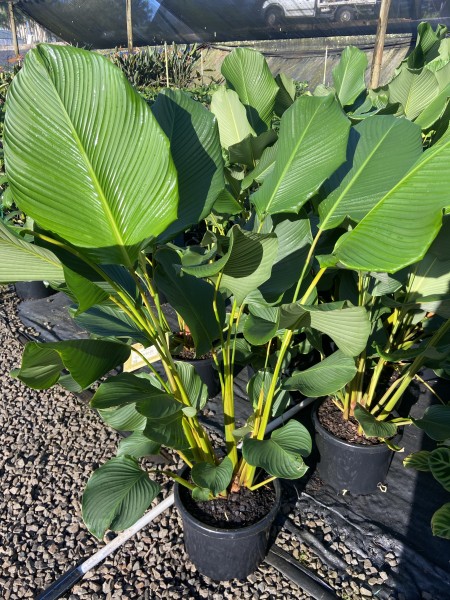 Image 1 of 1
Image 1 of 1


Calathea Lutea
🌿 Calathea lutea
Common Names:
Cigar Calathea, Havana Cigar, Pampano, Cuban Cigar Plant
Scientific Synonym:
Goeppertia lutea (updated classification under the Goeppertia genus)
Family:
Marantaceae (Prayer Plant family)
Native Range:
Native to tropical Central and South America—particularly Mexico, the Caribbean, and northern South America.
📏 Physical Description
Growth Habit:
A large, upright tropical plant that can grow 2–3 meters (6–10 feet) tall in ideal outdoor conditions.Leaves:
Huge, paddle-shaped leaves that resemble those of banana plants.
They are silvery-green to olive on the top and strikingly purple or burgundy underneath, with an elegant, waxy matte texture.
Leaves are typically 30–60 cm (12–24 inches) long or more.Stems:
Upright, thick, reed-like stalks, giving the plant a bold, architectural form.
🌸 Flowers
Appearance:
Produces bract-covered inflorescences that resemble cigars or cones—hence the name “Cigar Calathea.”
The flowers are usually rusty-orange to brownish-red, held within waxy, cigar-shaped green bracts.Bloom Time:
Usually blooms seasonally in tropical climates, but rarely flowers indoors.
🌱 Care and Cultivation
Light:
Prefers bright, indirect light to partial shade.
Too much direct sun can scorch the leaves; too little will reduce growth and leaf color vibrancy.Watering:
Likes consistent moisture—keep soil evenly moist but not soggy.
Avoid letting it dry out completely. Use filtered or rainwater if your tap water is hard, as it is sensitive to salts and fluoride.Humidity:
Thrives in high humidity (60–80%). If grown indoors, consider using a humidifier or placing it in a naturally humid room like a bathroom.Soil:
Well-draining but moisture-retentive.
A mix of peat/coco coir, perlite, and compost-rich potting soil works well.Temperature:
Ideal range: 18–30°C (65–86°F).
Not frost-tolerant—protect from temps below 10°C (50°F).Feeding:
Feed every 4–6 weeks during the growing season with a balanced liquid fertilizer diluted to half strength.Pruning:
Remove yellowing or damaged leaves to maintain a tidy appearance.
✅ Landscape & Indoor Uses
Tropical landscaping: Ideal for creating lush privacy screens or understorey layers.
Indoors: A statement plant in large pots near bright windows (protected from sun).
Architectural gardens: Works beautifully in Balinese- or resort-style gardens.
🪴 Quick Care Summary
RequirementDetailsLightBright, indirect to partial shadeWaterKeep soil evenly moistSoilRich, well-draining, moisture-retentiveHumidityHigh (60–80%)Temperature18–30°C (65–86°F), frost-sensitiveFeedingMonthly in growing season (spring–summer)SizeUp to 2–3m (6–10 ft) outdoors
⚠️ Common Issues
Brown leaf tips: Usually from low humidity or fluoride in tap water.
Curling or crispy leaves: Often a sign of underwatering or low humidity.
Leaf fading or scorching: Caused by too much direct sun.
Calathea lutea is a stunning choice for Brisbane’s subtropical climate—great both indoors and out, especially if you want tropical elegance with drama and height
🌿 Calathea lutea
Common Names:
Cigar Calathea, Havana Cigar, Pampano, Cuban Cigar Plant
Scientific Synonym:
Goeppertia lutea (updated classification under the Goeppertia genus)
Family:
Marantaceae (Prayer Plant family)
Native Range:
Native to tropical Central and South America—particularly Mexico, the Caribbean, and northern South America.
📏 Physical Description
Growth Habit:
A large, upright tropical plant that can grow 2–3 meters (6–10 feet) tall in ideal outdoor conditions.Leaves:
Huge, paddle-shaped leaves that resemble those of banana plants.
They are silvery-green to olive on the top and strikingly purple or burgundy underneath, with an elegant, waxy matte texture.
Leaves are typically 30–60 cm (12–24 inches) long or more.Stems:
Upright, thick, reed-like stalks, giving the plant a bold, architectural form.
🌸 Flowers
Appearance:
Produces bract-covered inflorescences that resemble cigars or cones—hence the name “Cigar Calathea.”
The flowers are usually rusty-orange to brownish-red, held within waxy, cigar-shaped green bracts.Bloom Time:
Usually blooms seasonally in tropical climates, but rarely flowers indoors.
🌱 Care and Cultivation
Light:
Prefers bright, indirect light to partial shade.
Too much direct sun can scorch the leaves; too little will reduce growth and leaf color vibrancy.Watering:
Likes consistent moisture—keep soil evenly moist but not soggy.
Avoid letting it dry out completely. Use filtered or rainwater if your tap water is hard, as it is sensitive to salts and fluoride.Humidity:
Thrives in high humidity (60–80%). If grown indoors, consider using a humidifier or placing it in a naturally humid room like a bathroom.Soil:
Well-draining but moisture-retentive.
A mix of peat/coco coir, perlite, and compost-rich potting soil works well.Temperature:
Ideal range: 18–30°C (65–86°F).
Not frost-tolerant—protect from temps below 10°C (50°F).Feeding:
Feed every 4–6 weeks during the growing season with a balanced liquid fertilizer diluted to half strength.Pruning:
Remove yellowing or damaged leaves to maintain a tidy appearance.
✅ Landscape & Indoor Uses
Tropical landscaping: Ideal for creating lush privacy screens or understorey layers.
Indoors: A statement plant in large pots near bright windows (protected from sun).
Architectural gardens: Works beautifully in Balinese- or resort-style gardens.
🪴 Quick Care Summary
RequirementDetailsLightBright, indirect to partial shadeWaterKeep soil evenly moistSoilRich, well-draining, moisture-retentiveHumidityHigh (60–80%)Temperature18–30°C (65–86°F), frost-sensitiveFeedingMonthly in growing season (spring–summer)SizeUp to 2–3m (6–10 ft) outdoors
⚠️ Common Issues
Brown leaf tips: Usually from low humidity or fluoride in tap water.
Curling or crispy leaves: Often a sign of underwatering or low humidity.
Leaf fading or scorching: Caused by too much direct sun.
Calathea lutea is a stunning choice for Brisbane’s subtropical climate—great both indoors and out, especially if you want tropical elegance with drama and height